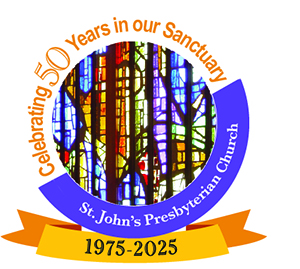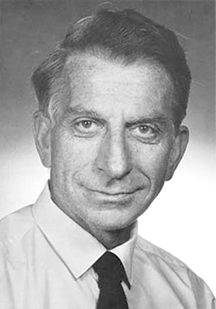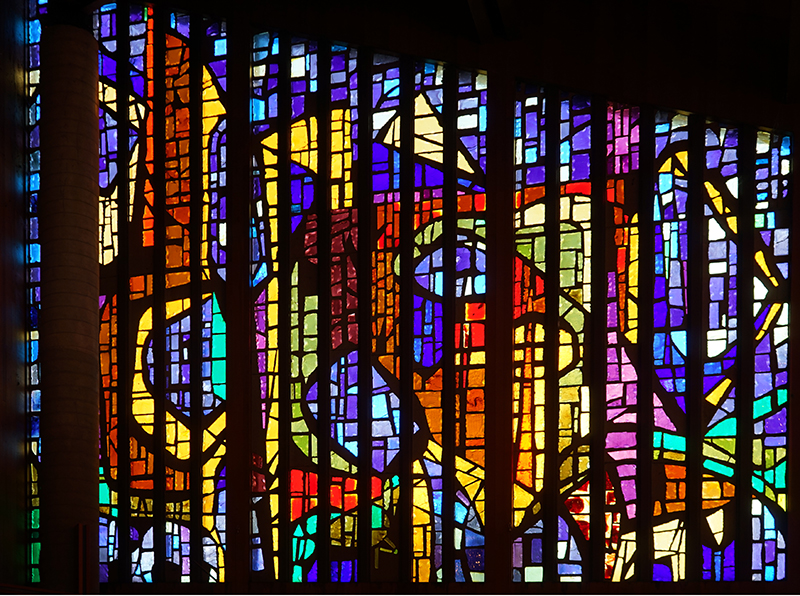

Our Sanctuary’s 50th Anniversary Celebration is on Sunday, May 18, 2025. St. John's is 118 years old, but the Sanctuary is turning 50 this year. Join us on Sunday, May 18 in Worship, and for a Party after worship on the lawn: Bring friends, family and neighbors. There will be a music, a bounce house, food and refreshments.
Here is some historical background ...
• How Our Beautiful Sanctuary Came into Being
• John Hans Ostwald, the Sanctuary's Architect
• Finding Sanctuary


How Our Beautiful Sanctuary Came into Being
Excerpted from Pastor Robert A. McKenzie's memoir "Life Keeps Coming at Me." The Reverend Robert McKenzie served as St. John's pastor, from 1966 to 1983, and presided over the Sanctuary's conception and construction.
On September 22nd, 1968, Pastor Jim Smith called a special meeting of the Session at his house for a momentous announcement. I had known from the beginning of my tenure what the announcement would be, but it was a matter held in strictest confidence. Dr. Howard Campbell, a Santa Barbara physician, willed to St. John's the bulk of his estate, about $1.5 million, to fund a memorial to his sister, a longtime St. John's member, whose funeral Jim conducted with Dr. Campbell in attendance. Dr. Campbell had no relatives and was so impressed with the affection shown by St. John's toward his sister, he wrote to Jim following the service to advise him of his intention. Now that Dr. Campbell had died, his lawyers notified Jim about his will. It would be enough to pay off the mortgage on the Center and to construct a Sanctuary and offices. The Session members left in a state of euphoria.
We directed the architects, John Hans Ostwald and his associate E. Paul Kelly, to design a user-friendly space where the worshipping community would be aware of one another, feel a sense of community rather than an assembly of isolated individuals. The space was to be hospitable — people space — warm and welcoming. We wanted the choir to be incorporated spatially into the congregation instead of set apart as a performance ensemble. The worship leaders were also to be integrated into the community and not be lifted above the people. Worship was seen as the work of the gathered community, not a performance by the preacher, choir and organist.
And so this space was designed in the round, the community gathered around the Lord's Table from which the worship is conducted. At the time of prayer, the pastor steps out from behind the table to engage the people in a pastoral manner, soliciting their concerns and offering up the pastoral prayer from among them. The entire worship drama is free of triumphalism, free of performance, expresses the spirit, the joy, the thanksgiving, the pain, the anguish of the people who are gathered in the light of the gospel.
Viewed from the outside, the Sanctuary is an imposing redwood structure, square in shape, with a copper roof that rises sharply from the center where the Sanctuary merges with the center to a high peak that faces on College Avenue. Just under the soaring peak, a majestic, burnished copper Celtic cross is fixed to the front facade. Inside, the entire structure is supported on two exposed concrete pillars, one at the entrance to the Sanctuary meets the center, the lower corner and one supporting the high peak behind the Communion table. A simple wooden cross is hung on this pillar, the perpendicular member measuring about 10 feet, the vertical member 6 feet. As a Jewish friend pointed out to me, the starkness of the cross attached to this concrete pillar conveys some of the harsh reality of Jesus’ crucifixion.
Eighteen months after construction began, on Sunday, April 13, 1975, St. John’s celebrated their first service in its new light-filled Sanctuary. After the service, the congregation was joined by the Chancellor of the university, the President of SFTS, the Mayor of Berkeley, the Moderator of the Presbytery, former pastor Jim Smith, the architect and construction crew for the dedication of our new facilities. Preceded on Saturday by a festival of the arts featuring musical performances and theater, the dedication of our new Sanctuary, at last, was in every way a grand occasion.
* Designed by Julia Morgan, on College Avenue, just up the street from the current location.

John Hans Ostwald, the Sanctuary's Architect
John Hans Ostwald (1913–1973) brought a quietly humanistic spirit to everything he designed. Born in Berlin and raised in Vienna, he was not only an architect, but also a gifted pianist, painter, and poet—someone who believed that art, in any form, should bring people closer to themselves and to one another. After earning his diploma from the Federal Institute of Technology in Zurich, he and his wife fled the rising threat of war and settled in the Bay Area, where Ostwald became a defining voice in the region’s architectural culture.
His work—spanning hundreds of homes, libraries, public buildings, and places of worship—embodied what came to be known as the Bay Region style: a relaxed, expressive, and deeply local way of building that honored both craft and community. He rejected formulaic solutions. Instead, he sought to design spaces that responded to their settings and to the lives unfolding within them.
In 1973, Ostwald began what would be the final project of his career—and, in many ways, its culmination: a major addition to an existing facility, the new sanctuary for St. John’s Presbyterian Church in Berkeley. He imagined a place of light and refuge, a generous wooden structure grounded in care and clarity, built to hold both everyday gatherings and extraordinary moments. Ostwald died suddenly in May of that same year, so the building was finished in 1975 by architect E. Paul Kelly, who faithfully followed his vision. Fifty years later, the sanctuary at St. John’s stands as the most profound expression of Ostwald’s architectural values: a space that listens, shelters, and quietly inspires.

Finding Sanctuary
by Gail Peterson, St. John's elder
Once upon a time long ago — very long, I lived in New York City, worked on the top floor of the landmark Flatiron Building and took a bus home up Fifth Avenue. A great "first" job, but "home" was a distressing living arrangement — which made the discovery of Fifth Avenue Presbyterian Church extraordinary. Nightly, on the very street where I stayed, I passed doors which opened to a small intimate place beside the primary building, a chapel.
That warmly lit, comforting space, so welcoming to one bundled up in winter clothing and too many cares for one so young, was like many I found over the years — from the chapels of castles and cathedrals to the simple, special place created for spiritual needs in hospitals or community centers. In all cases, what I experienced in such a small but beautiful environment was the sensation of resting in God's arms.
Many years later, when life had swept me all the way across the country, to Berkeley (my husband's hometown), I knew what I was looking for in a church home. Not only a safe landing but, much later in life, for the uplift of inspiration and fellowship, to hear and learn and sing praise and thanks for safe landings my whole life long.
I joined St. John's in 1976, a year after the completion of our sanctuary. True, I had the recommendation of this liberal community from my home church in the Midwest, but I was especially pleased to find myself wrapped in a redwood glow. Not for me, the cold, bright white of other sanctuaries in town. Here, streams of sunshine pour from clerestory windows over our heads and illuminate a wall-wide, gorgeous glass window. Those windowpanes hold brilliant abstract images — of creatures to discover over time, while immersed in the wondrous rumble of a venerable organ or receiving the Word from pastors who proclaim our community to be one in spirit with all sanctuary interpretations. Almost 50 years later, I sit in a pew and pray my thanks for the warmth that encloses and sustains me within the presence of the God who, for me, still defines care and hope for an uneasy mind, a raging world.


Videos of Sanctuary
Depending on your browser,
1) Click box on bottom (next to audio) to enlarge video, and then play
2) Start video, then click box on bottom (next to audio) to enlarge video
